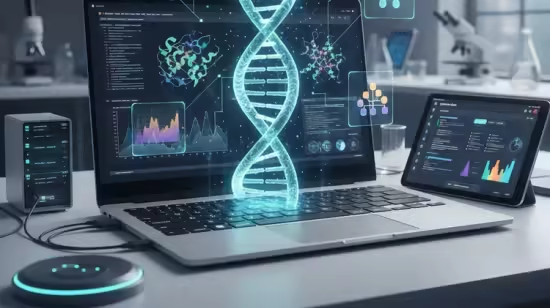
Published 10/2025
MP4 | Video: h264, 1280×720 | Audio: AAC, 44.1 KHz, 2 Ch
Language: English | Duration: 4h 31m | Size: 2.65 GB
Learn Python for Biological Data Analysis
What you’ll learn
Use Python basics in Colab to write code for biological data tasks like calculations, loops, and simple functions.
Work with lists, dictionaries, and sets to store and organize biological data; read and write CSV and FASTA files.
Analyze experimental data using NumPy and Pandas for stats, filtering, cleaning, and handling missing values.
Create scientific plots with Matplotlib, including histograms, scatter plots, and box plots for biological datasets.
Manipulate DNA/RNA sequences and apply statistical tests like t-tests and correlations using scipy.stats.
Build reproducible workflows using Biopython, organize code, and document results for sharing and publication.
Requirements
Basic understanding of molecular biology Familiarity with DNA, RNA, proteins, and experimental workflows (e.g., gene expression, sequencing).
Comfort with using a computer and web browser Ability to navigate online tools like Google Drive, upload/download files, and use web-based platforms.
No prior programming experience required The course starts from scratch with Python basics and builds up gradually.
Interest in data analysis and biological research Curiosity about how code can help interpret biological experiments and datasets.
Description
The “Python for Biological Data Analysis” course is a robust, intensive training program designed to bridge the gap between biological research and advanced computation. This course targets researchers, biologists, and students who need to effectively manage, analyze, and interpret the massive datasets generated by modern high-throughput technologies like next-generation sequencing and mass spectrometry.The curriculum starts by establishing a strong foundation in Python programming fundamentals, focusing on the control structures, data types, and functions necessary to write efficient, clean, and reusable code. Students then quickly transition into the core analytical ecosystem, gaining deep proficiency with the Scientific Python stack: NumPy for vectorized numerical operations, and Pandas for essential data wrangling, cleaning, and transformation of large tabular datasets like gene expression matrices.The program’s biological focus is achieved through hands-on mastery of Biopython. Participants learn to use its specialized classes to handle biological sequences (DNA, RNA, protein), parse common file formats (FASTA, GenBank, PDB), and execute fundamental bioinformatics tasks like sequence alignment, translation, and primer design.Beyond core manipulation, the course delves into advanced topics: processing Next-Generation Sequencing (NGS) data using libraries like Pysam for working with alignment files (BAM/SAM) and variant calling files (VCF). Students also explore statistical analysis and data visualization using SciPy, Matplotlib, and Seaborn to create publication-quality figures and perform hypothesis testing. The final modules introduce machine learning concepts using scikit-learn for tasks such as biological classification and clustering. By the end, students will possess the practical skills to design, execute, and troubleshoot automated, reproducible bioinformatics pipelines, positioning them as valuable assets in any data-intensive life science environment.
Password/解压密码www.tbtos.com